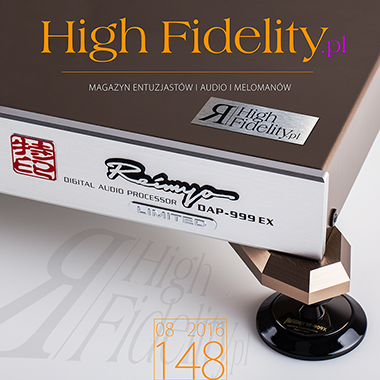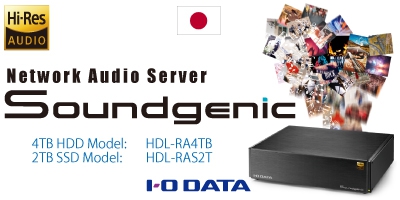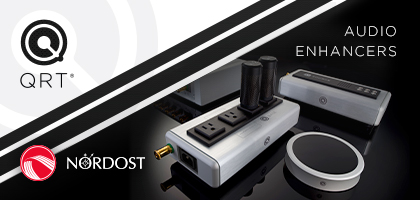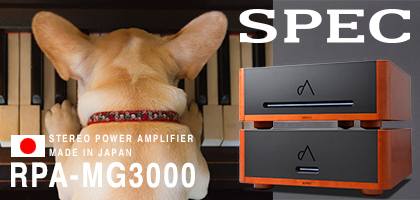No. 242 July 2024
- COVER REVIEW: Ferrum WANDLA GOLDENSOUND EDITION ⸜ digital-to-analog converter » POLAND
- AUDIO SHOW ⸜ coverage: HIGH END 2024 ⸜ Munich » GERMANY
- REVIEW: Daniel Hertz MARIA 350 ⸜ integrated amplifier » ITALY
- REVIEW: Lumin P1 MINI ⸜ file player » HONG KONG
- REVIEW: Thunder Melody AC FEMTO BLACK (2024) ⸜ AC power cable » POLAND
- REVIEW: Laiv HARMONY DAC ⸜ digital-to-analog converter » SIGAPORE
- MUSIC ⸜ review (in Polish): Three Blind Mice: KOSUKE, MOTOHIKO, YAMAMOTO ⸜ remaster 2024 • SACD/CD » JAPAN


|

|
|

Server – a music server by Dan D’Agostino is one of few examples proving that high-end finally accepted the newest technology Some clues could be found here and there in other authors SF, but Dick left this matter aside, focusing on psychology, trying to understand reality and to break out beyond it while, we should add, constantly studying "altered states of consciousness" ... The reality though, is that in the second decade of the twenty-first century, the signal is recorded almost entirely in a digital form on flash-drives or hard drives and the user no longer has to deal with the physical medium. This "almost" leaves still a niche that we, audiophiles, explore. Because even though in a very near future even high-end will be dominated by file players/streamers, a niche will still exist, which will have some particularly interesting things going on in it. And it might turn out that Dick was right after all, or his lack of interest will prove to be prophetic, and that in 21st century a turntable will still remain the main source of the signal in a number of high-end audio systems, and in the top-high-end one they will use reel-to-reel tape recorders listening to analog master tapes copies. Compact Disc: modifications So I wonder what will happen to the medium, which is still the most commonly sold music medium, meaning the Compact Disc? In many houses, cellars, warehouses, etc. they are in fact billions of CDs, and many experts are still trying to improve their production. These efforts resulted in new types of discs such as: XRCD (eXtended Resolution Compact Disc) by JVC, HQCD and UHQCD (respectively HiQuality CD and Ultimate HiQuality CD) by Toshiba-EMI, SHM-CD, and Platinum SHM-CD (Super High Material CD) offered by JVC and Universal Japan, as well as BSCD and BSCD2 (Blu-spec CD) by Sony Japan (HERE HERE). All these new types of discs are in fact sort of variations on Compact Disc and not some new formats. They are in short modifications of existing format. I won't be able to convince those who think CD format is obsolete, but those for whom this is still an important format know what I mean - each of these patents provides specific benefits and brings us closer to the “ultimate” source, ie. the master tape . Some of these companies have experimented with the material from which the discs are made (HQCD, UHQCD), the other with the reflecting layer (SHM-CD, Platinum SHM-CD), but historically the first one was the JVC idea about shortening the path which the signal has to travel from mastering studio to the finished, pressed CD. 
A diagram presenting the way of making a XRCD When we look at diagram that can be found in the booklet of every XRCD release, we can see that the most important element in the preparation of this type of disc, next to the precise clocking and whole power supply and K2 coding is shortening the process to a minimum and replacing the "intermediary master", ie digital master made of analog master-tape with a MO (Magneto-Optical Disc). If Sony had been able to promote this format properly, we would be one step closer to the master tape quality - on such discs one can store a 24 bit signal and the recording is particularly reliable over time. But it did not happen. So when we take up a Compact Disc, no matter how well prepared, we get a copy, mechanically made by encoding pits on a metal layer. One can find out about how imprecise is this way of production by listening to a Crystal Disc, where pits and lands (corresponding to "zeros" and "ones") are made in a much more sophisticated chemical process, and it would make no sense for to offer their BSCD and BSCD2 that are made on precise machines used also for the Blu-ray. What then, is the digital benchmark and are there are any differences between them and the final CD? This is a question is answered in many different ways. Usually the engineers, including those associated with the recording studios, as well as with production plants, negate the meaning of such modifications - for them "bit is a bit," and if the comparison of information (using computer software) does not show differences, it means for them that they're not there. I respect many of them and admire their work, but I do not agree with them on the subject - I believe that if the differences can be heard, and their comparison does not show them, it means that wrong things are measured. CD-R: Compact Disc Recordable As I already mentioned, the digital master at JVC was stored on MO. The "normal" world uses another standard: after the Sony U-matic (PCM-1600, -1610, -1630) digital tape recorders became obsolete, the intermediary master, ie. the medium used to deliver material to the production, started to be written on a CD-R . The emergence in 1988, of a Compact Disc Recordable format, described in the so-called "Orange Book", was a shock for those who thought that they could not write anything on the CD themselves. The 12 cm disc has a slightly different structure than a regular CD, but it is playable on the same players. The CD consists of three layers - (1) a thin polycarbonate, on which a reflective layer (aluminum, gold, silver, other alloys) is deposited (2) and on the bottom (3) there is a thicker polycarbonate. The glass matrix in the press plant makes sort of a "stamp" with pits and lands and then a reflective material and a protective layer is sprayed over it. In the CD-R disc case on a polycarbonate disc a spiral path (groove) is pressed. Then another layer of an organic dye is placed over it – something not present in the regular CD. This is a heat-shrinkable material, which under high temperature (about. 250º C) shrinks. Over this layer there is another, metal one made of aluminum, silver or gold, which reflects the laser beam. When heated by the laser beam an irreversible deformation occurs - the heated spot becomes impervious to light, the counterpart of it on a CD is a pit. Untreated spots let the light through and are the equivalent of a "land". 
Bogdan Hołownia's album Chwile… CD-R master . Initially this album was to be released by the Krakow label NotTwo, with a cover as presented on the picture (I have only a BW copy). But finally it was released by Sony Music Polska (5052882, 2001). Next there is the Artur Lesicki Acoustic Harmony, Stone & Ashes (Fonografika, 559040 2010) album and its Master CD-R ; CD-R is black Such discs look and "behave" like classic Compact Discs, and the only problem that had to be dealt with was a much lower reflectance of the laser light (by 40 - 70%) - this is why the early CD Players were not able to play CD-R. A selected dye plays an important role. Historically, the first was cyanine, invented by Taiyo Yuden, which was, however, extremely sensitive to UV light. Prices of CD-Rs quickly decreased and the ability to record them on any computer's writer meant that almost all mastering studios could use them. The pressing plant received a disk encoded in a special format - Disc Description Protocol (DDP). There is nothing, however, to prevent the mastering studio to back up the material in WAV (PCM) files, that one can play at home, on a CD Player. It would be a copy of the "master" on a physical media, which would be a Master CD-R. With it we would be closer to the recorded material in digital form than with a CD. And some companies do just that. MOVO: MAster VOice When some thirteen or fourteen years ago I received from Mr. Kobos, Supra CEO, a CD-R with the material from Bogdan Hołownia Moments ... album, I did not realize what I really held in my hands. The album sounded incredibly well, largely due to the fact that it was recorded under the watchful eye of Mr Kobos (the session took place in Larson Recording Studio in Chicago and was sponsored by Supra), but also because it was the "master" of which I speak. Fortunately, when in 2004 I received my another CD-R with the material from An Unbelievable Silence by Artur Lesicki Acoustic Harmony I already knew what it was. 
The album I thought about you by R-men, released on Master CD-R, bearing proprietary name CD-RIIα (T-TOC Records MCDR 3002, „Platinum Gold Sound”, 2010); price: 9800 YEN. The company used a CD-R with a cyan dye and applied their own print on it Both of these releases were, however, informal gifts and were not available for the public. Their production is in fact extremely costly, mainly because of the time needed for this and the manual nature of the work. However, if you're willing to pay a lot there are companies that will offer you this. One of them is the Japanese T-TOC Records. This label has its own studio and records material in the digital domain using 24/192 resolution. As I wrote once in the review of Kankawa Organist these guys are real quality fanatics. They offer the material in various formats, including the Master CD-R, which bears the company's proprietary name, CD-RIIα. CD-RIIα is burned on a selected medium with a green pigment directly from a hard drive of a computer where the material was saved, thus meeting the requirement of "master". Then the disc is subjected to demagnetization using Furutech device and undergoes some other treatments. The recording and burning processes take place only during the hours when there is least interference in the electric grid using Acoustic Revive cables. The writer they use is a modified Master Recorder (PlexWriter PremiumII). Mr Taiyo Yoden is the person responsible for the “production” of the discs and he is the only one who can touch them; the company believes that every person has his own "aura" that is transmitted to the objects he comes in contact with (the relationship between objects and people is characteristic one for Japan). 
Stan Getz & João Gilberto Getz/Gilberto album „24 Gold Direct-from-Master Edition UDM” Master CD-R There are three other CD-Rs in my collection that I'm proud of having, made by Mr. Winston Ma of the First Impression Music. This company offers several different versions of the same edition of the disc - the "normal" CD, but also a limited edition for the first 2,000 units, the gold version (The Collector's Edition UDC) and the Direct-from-Master Edition UDM, ie. CD -R on a gold disc. The latter is the most interesting one of course. After burning the disc is covered with a special paint in a process called Resonance Control Coated (RSS), and the edges are smoothed and cut under certain angle using Audiodesksysteme Glass The CD Sound Improver machine. The name of the buyer is then applied on the CD and he/she must declare never to sell of offer this particular disc to a third party. The album is considered to be a 2nd. degree master with the hard drive on which the remastering process was performed being treated as master of the 1st degree. CDs are inserted into the beautiful acrylic boxes with certificates and cover of the original edition. |
The Japanese quarterly released magazine „Stereo Sound” also offers their version of the reference CD. They were also a party responsible for the Crystal Disc with Glen Gould playing Bach (more HERE). For some time now "Stereo Sound" has offered in their shop a series of CDs under the name Stereo Sound Flat Transfer Series. These CD-R discs made directly from the analog master tape played on a Studer A-820 tape recorder. The music released in this series is completely unknown to me. These releases are very expensive (over 9800 yen plus customs duties, taxes and shipping). Maybe not quite as expensive as the Crystal Disc (8000-9000 PLN per piece), but expensive nevertheless. However, one can find artists who sell their music only in this way. Independent artists burn their discs "on demand" and even though they are not made in such a rigorous way, as mentioned above, listening to them makes us still feel close to the master. Let me remind you that I had an opportunity to listen to music of Piotr Szczepaniak in such a way, hiding under the name floating.point. In online auction services one can find something similar to the Master CD-R, i.e. a CD-R made for the needs of radio stations, DJs, or for promotional purposes. They come directly from the labels, but it is difficult to call them "masters". This is usually a copy of the finished CD, and sometimes – I have a feeling - the converted MP3 files. I have several of them and I can say that the quality of the recorded sound on them is debatable. Comparison 
Discs used for comparison CD-R media is not an ideal medium. As indicated in many studies, it is not particularly reliable over time and it begins to lose information right after it is burned. But it is not a rapid process, and losses are not significant. This medium is actually not alone in this entropy: namely also CDs, analogue tapes, and flash drives storing digital data share similar problems. The only medium immune to the passage of time is a vinyl record. To give you a better idea about the differences between pressed CD and CD-R Master with exactly the same material, I compared several recordings from different years:

Demagnetization of CD-R bring similar benefits as for the regular CD When starting my listening sessions I assumed that first I would try to answer the question whether the differences between CD and CD-R are actually there and then - if there are some – I would look for common features of these changes. During the session it turned out, however, that the changes - the answer to question no. 1 was an unequivocal: YES - manifest themselves in different ways, depending on: 1) the person who prepared the master CD-R, and 2) on the music itself. It was much easier for me to point out common features of Mr. Winston Ma's (First Impression Music) masters, as well as Jacek Gawłowski's (JG Master Lab) than between the discs from different labels. The biggest differences I heard comparing the disc by Mr. Winston Ma and Jacek Gawłowski. With First Impression Music releases the Master CD-R is much cleaner, more distinct. The tonal balance is shifted up and everything seems brighter. The CD version had a lower placed tonal balance, and the instruments and voices seemed to come out to the listening room. Normally I would say that it is a good thing, that this is how I like it. Here, however, because I had a point of reference, I heard that this sound was "made", that the CD-R sounded more natural, it reminded me more of the nature of an analog tape (I'm talking in general about the characteristics of the medium). I felt closer to the music with it, closer to the performers. With the CD, I was closer to the studio. 
Komeda Quintet, Astigmatic, „Polish Jazz Vol. 5": CD vs Master CD-R (MAM-A Audio on gold disc) Very similar feelings accompanied my session with Master CD-R discs with the first five volumes of the Polish Jazz remaster prepared by Jacek Gawłowski, with particular emphasis on the Komeda Quintet ASTIGMATIC. Versions on CD-R sound more "raw" - the thing I noticed earlier with FIM releases. The first impression is that everything is clearer and brighter. After accommodation I came to the conclusion that the CD version is just off and less clear. The treble is slightly rounded, and the bass has no such clear attack. In a slightly less intense way, these changes could be heard in the case of the Aquavoice album. CD-R offered more information and a more relaxed sound. CD sounded bluntly and more "clear", but because of it also a little more “raw”. Just to be clear - both versions are great, but if you compare them A/B, even such small shifts are significant. The Artur Lesicki Acoustic Harmony album proved most difficult to assess. It is possible that the passage of time (CD-R was burned 6 years ago) had some influence here, I do not know that. It was not even a matter of lack of differences, but about difficulty when it came to describing them. After a long time I can say, however, that the CD-R sounded better, more clearly, it is more interesting. CD seems to be "polished", and a lot of "fringe" information is gone that make up the atmosphere of the recording. A conclusion concerning the Master CD-R in general that stuck in my memory for a long time, was that the music from them at first seems to be more raw and not as "smooth" as the from CD. This reminds me of a comparison between SHM-CD and Platinum SHM-CD, in which the latter version sounds like Master CD-R. This could be an indirect evidence that the improvement of methods of CD pressing brings us closer to the digital "master" that leaves the mastering studio. 
The Aquavoice Watermusic and Krzysztof Duda Altus albums, CD and CD-R – the latter burned on musicians computers Bit after bit It so happened that in 1948, Bell Telephone Laboratories announced the invention of a small electronic semiconductor, an "amazingly simple device," acting just like a vacuum tube, but more effectively. [...] In May 1948, the researchers established a commission to come up with a name. [...] The “transistor” (from "varistor" and "transduction" – ed.) won. [...] The transistor sparked a revolution in electronics, introducing technology that allowed miniaturization and ubiquity, and the three main inventors of the said company soon were honored with the Nobel Prize. However, this was the second most important discovery of that year. The transistor was only an equipment. Although the "music on the computer," only a few years has the quality that can be compared with the CD and vinyl, the idea is at least 75 years old. As such it is therefore almost of the same age as the analog tape recorder, in the world of absolute audio standard, and is older than the Long Play. During this time we have seen countless audio formats, most of which were never even commercially implemented, a large proportion of those that were didn't last long, and only a few have become standards. Of these the most common was a small, shiny Compact Disc. For me personally, it is still the best digital source. This all the new solutions, improvements within the Red Book standard are welcome by me with curiosity and sometimes with an appreciation. Whatever they come up with next, however, in the digital world the Master CD-R is something that - to paraphrase Stanislaw Lem, one could called "the voice of the Lord" ... 
System used for comparisons WOJCIECH PACUŁA Further recommended reading:
|
About Us |
We cooperate |
Patrons |
|
Our reviewers regularly contribute to “Enjoy the Music.com”, “Positive-Feedback.com”, “HiFiStatement.net” and “Hi-Fi Choice & Home Cinema. Edycja Polska” . "High Fidelity" is a monthly magazine dedicated to high quality sound. It has been published since May 1st, 2004. Up until October 2008, the magazine was called "High Fidelity OnLine", but since November 2008 it has been registered under the new title. "High Fidelity" is an online magazine, i.e. it is only published on the web. For the last few years it has been published both in Polish and in English. Thanks to our English section, the magazine has now a worldwide reach - statistics show that we have readers from almost every country in the world. Once a year, we prepare a printed edition of one of reviews published online. This unique, limited collector's edition is given to the visitors of the Audio Show in Warsaw, Poland, held in November of each year. For years, "High Fidelity" has been cooperating with other audio magazines, including “Enjoy the Music.com” and “Positive-Feedback.com” in the U.S. and “HiFiStatement.net” in Germany. Our reviews have also been published by “6moons.com”. You can contact any of our contributors by clicking his email address on our CONTACT page. |




 |
     |
main page | archive | contact | kts
© 2009 HighFidelity, design by PikselStudio,
projektowanie stron www: Indecity







 hilip K. Dick, one of the most famous but also most crazy (figuratively but also literally speaking) visionaries of the science-fiction world, author of such novels as: Blade Runner (1968), The Three Stigmata of Palmer Eldritch (1964) and The Man in the High Castle, (1962), that several films and TV series were based on, despite his great insight into man's and whole society's nature, was deeply stuck in his times unable to guess which inventions would be truly important in the future he described. Nobody could actually guess that wireless communication would become a key element of modern world, or what sort of impact would Internet bring. Nor how in the future people would record and playback the sound/music.
hilip K. Dick, one of the most famous but also most crazy (figuratively but also literally speaking) visionaries of the science-fiction world, author of such novels as: Blade Runner (1968), The Three Stigmata of Palmer Eldritch (1964) and The Man in the High Castle, (1962), that several films and TV series were based on, despite his great insight into man's and whole society's nature, was deeply stuck in his times unable to guess which inventions would be truly important in the future he described. Nobody could actually guess that wireless communication would become a key element of modern world, or what sort of impact would Internet bring. Nor how in the future people would record and playback the sound/music.


